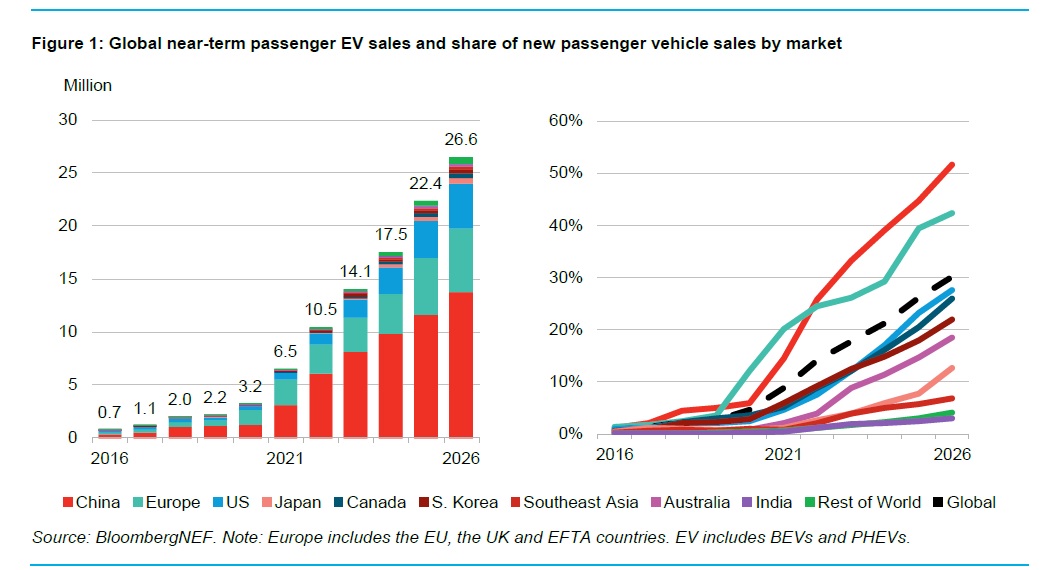From pv magazine USA
The transportation sector is the leading source of carbon emissions in the United States, according to the US Environmental Protection Agency (EPA), but electrifying vehicles across various categories will significantly contribute to decarbonization efforts.
Electric vehicle sales at the global level are expected to rise from 10.5 million in 2022 to almost 27 million in 2026, BloombergNEF says in a new report. It notes that the EV share of global new passenger vehicle sales will grow from 14% in 2022 to 30% in 2026. Shares in some markets are much higher, with the report estimating that EVs will reach more than half the sales in China and 42% in Europe.
In the United States, electric vehicles will make up nearly 28% of passenger vehicle sales by 2026, up from 7.6% in 2022, due to incentives offered by the Inflation Reduction Act (IRA). This projection is about 20% off from the Biden administration’s goal for electric vehicles to make up 50% of all vehicles sold in the United states by 2030, but perhaps the goal will be met with four years of additional growth.
The IRA provides incentives for buyers of new and used EVs that are made in North America. While there previously was a limit of 200,000 vehicles per manufacturer that could receive the incentive, the cap was lifted with the IRA. Also in 2023, new auto pricing and buyer income caps apply; however, if a taxpayer does not qualify, they may transfer the credit to the dealer, who can then offer a rebate to the customer.
According to SAFE, a group dedicated to accelerating the deployment of sustainable transportation and energy solutions of the United States and its sister organization, the Electrification Coalition, EVs must also meet critical mineral and battery component requirements to qualify for the maximum credit available. The IRA also stipulates that battery minerals and components come from North America or from countries with which the United States has free trade agreements.
Popular content
The US government is also helping to meet its own goals by increasing procurement of electric vehicles for the federal fleet. According to a White House report, government agencies in this fiscal year have acquired five times as many EVs as last year, and are on track to meet the goal for 100% of new light-duty federal vehicles to be zero emission by 2027.
BloombergNEF notes that electrification is spreading to all types of vehicles, with light commercial EV sales expected to rise sharply. Municipal bus fleets are increasingly electric and are expected to reach 36% of sales by 2026.
While the trajectory of EV sales is impressive, BloombergNEF cautions that faster progress is needed in order to reach net-zero road transport emissions by 2050. The IRA has gone a long way to promote the adoption of electric cars in the United States, but heavy trucks are still lagging behind in the trajectory and should be a priority focus, according to the report authors.
Other challenges inherent in an EV buildout remain, including the need for a strong network of charging stations. The Biden administration set a goal of establishing a national network of 500,000 EV chargers. While ambitious, a recent report from Wood Mackenzie forecasts that 18 million chargers will be installed across the United States by 2027.
This content is protected by copyright and may not be reused. If you want to cooperate with us and would like to reuse some of our content, please contact: editors@pv-magazine.com.



4 comments
By submitting this form you agree to pv magazine using your data for the purposes of publishing your comment.
Your personal data will only be disclosed or otherwise transmitted to third parties for the purposes of spam filtering or if this is necessary for technical maintenance of the website. Any other transfer to third parties will not take place unless this is justified on the basis of applicable data protection regulations or if pv magazine is legally obliged to do so.
You may revoke this consent at any time with effect for the future, in which case your personal data will be deleted immediately. Otherwise, your data will be deleted if pv magazine has processed your request or the purpose of data storage is fulfilled.
Further information on data privacy can be found in our Data Protection Policy.